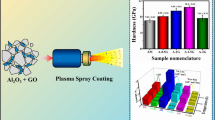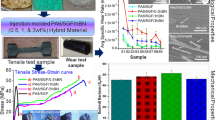Abstract
The electrical contact and mechanical performances of Ag-SnO2 contact materials are often improved by additives, especially Cu and its oxides. To reveal the improvement mechanism of metal additive, the effects of Cu nanoparticles on the interface strength and failure behavior of the Ag-SnO2 contact materials are investigated by numerical simulations and experiments. Three-dimensional representative volume element (RVE) models for the Ag-SnO2 materials without and with Cu nanoparticles are established, and the cohesive zone model is used to simulate the interface debonding process. The results show that the stress—strain relationships and failure modes predicted by the simulation agree well with the experimental ones. The adhesion strengths of the Ag/SnO2 and Ag/Cu interfaces are respectively predicted to be 100 and 450 MPa through the inverse method. It is found that the stress concentration around the SnO2 phase is the primary reason for the interface debonding, which leads to the failure of Ag-SnO2 contact material. The addition of Cu particles not only improves the interface strength, but also effectively suppresses the initiation and propagation of cracks. The results have an reference value for improving the processability of Ag based contact materials.
摘要
Ag-SnO2 触点材料的电接触和力学性能常采用添加剂(特别是铜及其氧化物)来改善. 为揭示金属添加剂的改善机制, 采用实验和数值模拟相结合的方法研究了Cu 纳米颗粒对Ag-SnO 2 触点材料的界面强度和失效行为的影响. 建立了有/无Cu 纳米颗粒的Ag-SnO 2 材料的三维代表性体积元(RVE)模型, 通过内聚力模型模拟了界面脱粘过程. 结果表明, 模拟获得的应力& minus; 应变曲线和破坏模式与实验结果吻合良好; 通过反推法预测得到Ag/SnO2 和Ag/Cu 界面的强度分别为100 和450 MPa. 研究发现, SnO2 相周围的应力集中是引起界面脱粘的主要原因, 从而导致Ag-SnO 2 触点材料失效; Cu 颗粒的加入不仅提高了界面强度, 而且有效抑制了裂纹的萌生和扩展. 研究结果对提高银基触点材料的加工性能具有参考价值.
Similar content being viewed by others
References
BRAUNOVIC M, MYSHKIN N K, KONCHITS V. Electrical contacts: Fundamentals, applications and technology [M]. CRC Press, 2006. DOI: https://doi.org/10.1201/9780849391088.
LUNGU M, GAVRILIU S, CANTA T, et al. AgSnO2 sintered electrical contacts with ultrafine and uniformly dispersed microstructure [J]. Journal of Optoelectronics and Advanced Materials, 2006, 8: 576–581.
BEHRENS V, HONIG T, KRAUS A, et al. An advanced silver/tin oxide contact material [J]. IEEE Transactions on Components, Packaging, and Manufacturing Technology: Part A, 1994, 17(1): 24–31. DOI: https://doi.org/10.1109/95.296364.
BIYIK S. Effect of reinforcement ratio on physical and mechanical properties of Cu-W composites synthesized by ball milling [J]. Materials Focus, 2018, 7(4): 535–541. DOI: https://doi.org/10.1166/mat.2018.1513.
BIYIK S. Effect of cubic and hexagonal boron nitride additions on the synthesis of Ag-SnO2 electrical contact material [J]. Journal of Nanoelectronics and Optoelectronics, 2019, 14(7): 1010–1015. DOI: https://doi.org/10.1166/jno.2019.2592.
BIYIK S, AYDIN M. Fabrication and arc-erosion behavior of Ag8SnO2 electrical contact materials under inductive loads [J]. Acta Physica Polonica A, 2017, 131(3): 339–343. DOI: https://doi.org/10.12693/aphyspola.131.339.
BIYIK S. Characterization of nanocrystalline Cu25Mo electrical contact material synthesized via ball milling [J]. Acta Physica Polonica A, 2017, 132(3-II): 886–888. DOI: https://doi.org/10.12693/aphyspola.132.886.
LIN Zhi-jie, LIU Shao-hong, SUN Xu-dong, et al. The effects of citric acid on the synthesis and performance of silver-tin oxide electrical contact materials [J]. Journal of Alloys and Compounds, 2014, 588: 30–35. DOI: https://doi.org/10.1016/j.jallcom.2013.10.222.
WANG Jing-qin, LIU Zhou, CHEN Ling, et al. Effect of CuF co-doping on the properties of AgSnO2 contact [J]. Materials (Basel, Switzerland), 2019, 12(14): 2315. DOI: https://doi.org/10.3390/ma12142315.
ZHANG Zhi-hao, JIANG Yan-bin, CHEN Yong-tai. Microstructure and deformation mechanism of Ag-12wt% SnO2 composite during hot compression [J]. Journal of Alloys and Compounds, 2017, 728: 719–726. DOI: https://doi.org/10.1016/j.jallcom.2017.09.013.
ZHENG Ji, LI Song-lin, GUO Jing. The influence of rare earth oxide on the structure and properties of AgSnO2 electrical contact materials [J]. Advanced Materials Research, 2012, 479–481: 1986–1989. DOI: https://doi.org/10.4028/www.scientific.net/amr.479-481.1986.
WANG Jing-qin, ZHANG Ying, KANG Hui-ling. Study on properties of AgSnO2contact materials doped with rare earth Y [J]. Materials Research Express, 2018, 5(8): 085902. DOI: https://doi.org/10.1088/2053-1591/aad24b.
ZHENG Ji, LI Song-lin, DOU Fu-qi, et al. Preparation and microstructure characterization of a nano-sized Ti4+-doped AgSnO2 electrical contact material [J]. Rare Metals, 2009, 28(1): 19–23. DOI: https://doi.org/10.1007/s12598-009-0005-7.
ZHOU Xiao-long, CHEN Li, LIU Man-men, et al. Effects of NiO content on the microstructure and mechanical properties of AgSnO2NiO composites [J]. Science and Engineering of Composite Materials, 2019, 26(1): 221–229. DOI: https://doi.org/10.1515/secm-2019-0005.
LI Gui-jing, YANG Tian-yang, MA Yuan-yuan, et al. The effects of oxide additives on the mechanical characteristics of Ag-SnO2 electrical contact materials [J]. Ceramics International, 2020, 46(4): 4897–4906. DOI: https://doi.org/10.1016/j.ceramint.2019.10.226.
WANG Jia-zhen, WANG Ya-ping, YANG Zhi-mao, et al. Effect of CuO additive on the wettability and interface behavior of silver/tin oxide [J]. Rare Metal Materials and Engineering, 2005(3): 405–408. (in Chinese)
WANG Ya-ping, LI Hai-yan. Improved workability of the nanocomposited AgSnO2 contact material and its microstructure control during the arcing process [J]. Metallurgical and Materials Transactions A, 2017, 48(2): 609–616. DOI: https://doi.org/10.1007/s11661-016-3859-y.
WANG Jun, LIU Wei, LI Dong-mei, et al. The behavior and effect of CuO in Ag/SnO2 materials [J]. Journal of Alloys and Compounds, 2014, 588: 378–383. DOI: https://doi.org/10.1016/j.jallcom.2013.11.040.
LIU Song-tao, SUN Qiao-yan, WANG Jun-bo, et al. How Cu doping improves the interfacial wettability between Ag and SnO2 of Ag/SnO2 contact material [J]. Journal of Alloys and Compounds, 2019, 792: 1248–1254. DOI: https://doi.org/10.1016/j.jallcom.2019.04.134.
KAPLAN W D, CHATAIN D, WYNBLATT P, et al. A review of wetting versus adsorption, complexions, and related phenomena: The Rosetta stone of wetting [J]. Journal of Materials Science, 2013, 48(17): 5681–5717. DOI: https://doi.org/10.1007/s10853-013-7462-y.
TUAN W H, LEE S K. Eutectic bonding of copper to ceramics for thermal dissipation applications — A review [J]. Journal of the European Ceramic Society, 2014, 34(16): 4117–4130. DOI: https://doi.org/10.1016/j.jeurceramsoc.2014.07.011.
XU Fu-tai, CHEN Jing-chao, YU Jie, et al. Study on workability and simulation of Ag-SnO2 composites[J]. Precious Metals, 2009, 30(3): 21–25. DOI: https://doi.org/10.3969/j.issn.1004-0676.2009.03.006.
LI Jin-tao, XIONG Ai-hu, ZHANG Xiao, et al. Effect of CuO and SnO2 particle size on hot extrusion deformation of AgCuOSnO2: Finite element simulation and experimental study [J]. Journal of Central South University, 2021, 28(3): 633–647. DOI: https://doi.org/10.1007/s11771-021-4633-x.
LI Gui-jing, MA Yuan-yuan, ZHANG Xiao-long, et al. Interface strengthening and fracture characteristics of the Ag-based contact materials reinforced with nanoporous SnO2 (Cu, CuO) phases [J]. Applied Surface Science, 2021, 543: 148812. DOI: https://doi.org/10.1016/j.apsusc.2020.148812.
MA Yuan-yuan, YANG Tian-yang, FENG Wen-jie, et al. Improved fracture resistance of the Ag/SnO2 contact materials using Cu nanoparticles as additive [J]. Journal of Alloys and Compounds, 2020, 843: 156055. DOI: https://doi.org/10.1016/j.jallcom.2020.156055.
ZHANG J F, ZHANG X X, WANG Q Z, et al. Simulation of anisotropic load transfer and stress distribution in sicp/Al composites subjected to tensile loading [J]. Mechanics of Materials, 2018, 122: 96–103. DOI: https://doi.org/10.1016/j.mechmat.2018.04.011.
WU Qi, XU Wei-xing, ZHANG Liang-chi. Microstructure-based modelling of fracture of particulate reinforced metal matrix composites [J]. Composites Part B: Engineering, 2019, 163: 384–392. DOI: https://doi.org/10.1016/j.compositesb.2018.12.099.
JAGADEESH G V, GANGISETTI S. A review on micromechanical methods for evaluation of mechanical behavior of particulate reinforced metal matrix composites [J]. Journal of Materials Science, 2020, 55(23): 9848–9882. DOI: https://doi.org/10.1007/s10853-020-04715-2.
ZHANG Jie, OUYANG Qiu-bao, GUO Qiang, et al. 3D Microstructure-based finite element modeling of deformation and fracture of SiCp/Al composites [J]. Composites Science and Technology, 2016, 123: 1–9. DOI: https://doi.org/10.1016/j.compscitech.2015.11.014.
MISHNAEVSKY L L. Three-dimensional numerical testing of microstructures of particle reinforced composites [J]. Acta Materialia, 2004, 52(14): 4177–4188. DOI: https://doi.org/10.1016/j.actamat.2004.05.032.
QING Hai. Automatic generation of 2D micromechanical finite element model automatic generation of 2D micromechanical finite element model [J]. Materials & Design, 2013, 44: 446–453. DOI: https://doi.org/10.1016/j.matdes.2012.08.011.
ZHANG Wan-ting, CHEN Hua-hui, PRENTKI R. Numerical analysis of the mechanical behavior of ZTAp/Fe composites [J]. Computational Materials Science, 2017, 137: 153–161. DOI: https://doi.org/10.1016/j.commatsci.2017.05.021.
YANG X, WU G Q, SHA W, et al. Numerical study of the effects of reinforcement/matrix interphase on stress-strain behavior of YAl2 particle reinforced MgLiAl composites [J]. Composites Part A: Applied Science and Manufacturing, 2012, 43(3): 363–369. DOI: https://doi.org/10.1016/j.compositesa.2011.12.010.
LIU Qing, QI Fu-gong, WANG Qiang, et al. The influence of particles size and its distribution on the degree of stress concentration in particulate reinforced metal matrix composites [J]. Materials Science and Engineering: A, 2018, 731: 351–359. DOI: https://doi.org/10.1016/j.msea.2018.06.067.
GAD S I, ATTIA M A, HASSAN M A, et al. A random microstructure-based model to study the effect of the shape of reinforcement particles on the damage of elastoplastic particulate metal matrix composites [J]. Ceramics International, 2021, 47(3): 3444–3461. DOI: https://doi.org/10.1016/j.ceramint.2020.09.189.
YING Liang, GAO Tian-han, RONG Hai, et al. On the thermal forming limit diagram (TFLD) with GTN mesoscopic damage model for AA7075 aluminum alloy: Numerical and experimental investigation [J]. Journal of Alloys and Compounds, 2019, 802: 675–693. DOI: https://doi.org/10.1016/j.jallcom.2019.05.342.
SHARMA N K, MISHRA R K, SHARMA S. 3D micromechanical analysis of thermo-mechanical behavior of Al2O3/Al metal matrix composites [J]. Computational Materials Science, 2016, 115: 192–201. DOI: https://doi.org/10.1016/j.commatsci.2015.12.051.
MA Yuan-yuan, YANG Tian-yang, LI Gui-jing, et al. Effect of nano-metal additives on the creep behavior of AgSnO2 contact materials [J]. Materials Chemistry and Physics, 2021, 272: 124939. DOI: https://doi.org/10.1016/j.matchemphys.2021.124939.
ZHANG J F, ZHANG X X, WANG Q Z, et al. Simulations of deformation and damage processes of SiCp/Al composites during tension [J]. Journal of Materials Science & Technology, 2018, 34(4): 627–634. DOI: https://doi.org/10.1016/j.jmst.2017.09.005.
Author information
Authors and Affiliations
Corresponding author
Additional information
Foundation item
Projects(11872257, 11572358) supported by the National Natural Science Foundation of China; Project(ZD2018075) supported by the Hebei Provincial Education Department, China
Contributors
MA Yuan-yuan provided the concept and wrote the draft of the manuscript. LI Gui-jing edited the draft of manuscript. FENG Wen-jie analyzed and checked the results. All authors replied to reviewers’ comments and revised the final version.
Conflict of interest
The authors declare that they have no conflict of interest or personal relationships that could have appeared to influence the work reported in this paper.
Rights and permissions
About this article
Cite this article
Ma, Yy., Li, Gj. & Feng, Wj. Numerical investigation on interface enhancement mechanism of Ag-SnO2 contact materials with Cu additive. J. Cent. South Univ. 29, 1085–1097 (2022). https://doi.org/10.1007/s11771-022-4981-1
Received:
Accepted:
Published:
Issue Date:
DOI: https://doi.org/10.1007/s11771-022-4981-1




